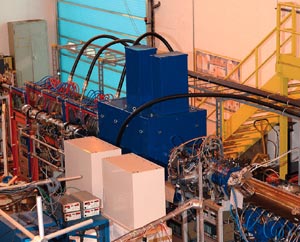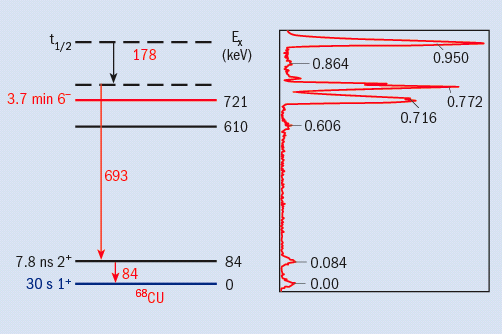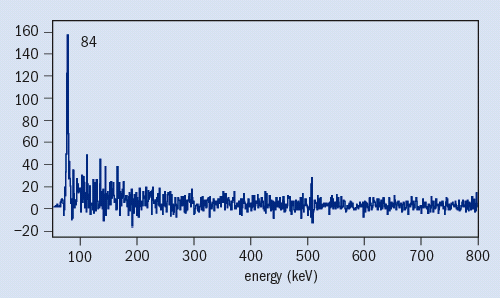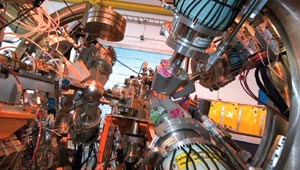CERN’s REX-ISOLDE facility has opened up a new avenue for nuclear investigations by accelerating isomeric beams for the first time, as Georgi Georgiev explains.

Since 2001, the combination of the Isotope-Separator On-Line (ISOLDE) and the Radioactive Beam Experiment (REX) has provided accelerated beams of radioactive ions. Now, with the aid of a laser-separation technique, specific metastable excited states – isomers – can be selected and “post-accelerated” in REX. This allows not only nuclear-decay experiments, but also the production of short-lived excited states.
Purity is an important parameter of any radioactive beam. At ISOLDE, the Resonant Ionisation Laser Ion Source (RILIS) allows the selection of a single chemical element. Combined with the mass selection of the ISOLDE separators, this results in a high-purity beam composed of essentially a single isotope. In a further step, narrow-bandwidth lasers can select different long-lived isomers from the same isotope (Köster et al. 2000a and 2000b). This has already allowed the separation of two different beta-decaying states in 68Cu as well as the unambiguous identification of three isomeric states in 70Cu (Van Roosbroeck et al. 2004). (These are both neutron-rich radioactive isotopes of copper, which occurs naturally as the stable isotopes 63Cu and 65Cu.)
Now, in experiment IS435, isomeric beams of 68Cu and 70Cu have been post-accelerated in REX-ISOLDE to 2.8 MeV per nucleon. The beams were then directed onto a target in the centre of the Miniball set-up, which was used to detect emitted gamma rays, and hence the existence of excited states in the different nuclei. The experiments are showing that the technique can produce isomeric beams of sufficient purity to study individual excited states in a radioactive nucleus, as the preliminary results for 68Cu indicate.
The radioactive nucleus 68Cu has two beta-decaying states, the ground state with spin 1 and positive parity (Iπ = 1+) and a metastable (isomeric) one with Iπ = 6–. Both states are well known and decay to the stable 68Zn nucleus. In nuclei, protons and neutrons tend to fill energy levels in pairs, with the angular momentum of the pairs coupling to zero. So in 68Cu, with an odd number of protons (29) and an odd number of neutrons (39), the multiplet structure of the low-lying energy states is largely determined by the coupling of the two odd nucleons, which occupy different orbitals outside the full core of pairs. The structures containing the ground state and the beta-decaying isomeric state are expected to be significantly different, as in these states, although the odd proton is in the same orbital (2p3/2), the odd neutron is in very different orbitals (2p1/2 and 1g9/2). Previous investigations using transfer reactions (Sherman et al. 1977) and beta-decay and lifetime measurements (Hou et al. 2003) have indicated the existence of different multiplet structures (figure 1), but not much is known about the composition of the states.

The aim of experiment IS435 was to study these two multiplet structures. In one case, an almost pure (∼90%) beam of the ground state of 68Cu (1+) was accelerated and underwent Coulomb excitation in order to investigate the coupling between the proton p3/2 and neutron p1/2 orbitals. Figure 2 shows the gamma-ray energy spectrum from the Miniball detector. It clearly reveals a gamma transition of 84 keV indicating that the Iπ = 2+ state of the ground-state multiplet is excited with quite a high probability. This hints at a significant electric quadrupole (E2) component in the transition connecting these two states, contradicting the conclusions of some previous studies (Hou et al. 2003).
Figure 3 shows the gamma-ray energy spectrum from the excitation of the isomeric 6– state of 68Cu. Here a Doppler-broadened line is clearly visible at 178 keV together with lines at 84 keV and 693 keV that are not Doppler-broadened. Applying the Doppler correction to the spectrum (the red line in the figure) leads to a narrowing of the 178 keV line and a broadening or complete disappearing of the 84 keV and 693 keV lines respectively. This indicates that the gamma rays from these two transitions were not emitted in flight but from nuclei at rest – in other words from states that have relatively long half-lives compared with the other states excited, and that therefore come to rest before they decay. Taking into account the energy of the beam leads to an estimate of the half-lives of these two transitions of the order of a few nanoseconds. Comparing the results from the transfer reaction and beta decay indicates positions for the two states as given by the dashed lines in figure 1.

The distinctively different patterns of the spectra in figures 2 and 3 prove that two different isomeric beams with sufficient purity have been post-accelerated at REX-ISOLDE and that completely different structures in the 68Cu nucleus have been populated and studied. This is the first instance of such studies being carried out with the help of post-accelerated isomeric beams.

A number of techniques for nuclear studies, including Coulomb excitation and nuclear transfer reactions, will clearly benefit from the use of isomeric beams. The very high selectivity of RILIS combined with the very good beam spot and precise energy definition after the REX linac make REX-ISOLDE a unique place for this type of measurement during the coming years.

• IS435 was performed by CERN; IKS KU Leuven; INRNE, Bulgarian Academy of Sciences, University of Sofia; Universita di Camerino; LMU, Munich; MPI, Heidelberg; University of Köln; TU Darmstadt; TU Munich; Warsaw University; IPN Orsay; Lund University; INP, NCSR “Demokritos”; University of Gent; Miniball and the REX collaboration.
Further reading
L Hou et al. 2003 Phys. Rev. C68 54306.
U Köster et al. 2000a Nucl. Instr. and Meth. B160 528.
U Köster et al. 2000b Hyperfine Interactions 127 417.
J D Sherman et al. 1977 Phys. Lett. B67 275.
J Van Roosbroeck et al. 2004 Phys. Rev. Lett. 92 112501.





